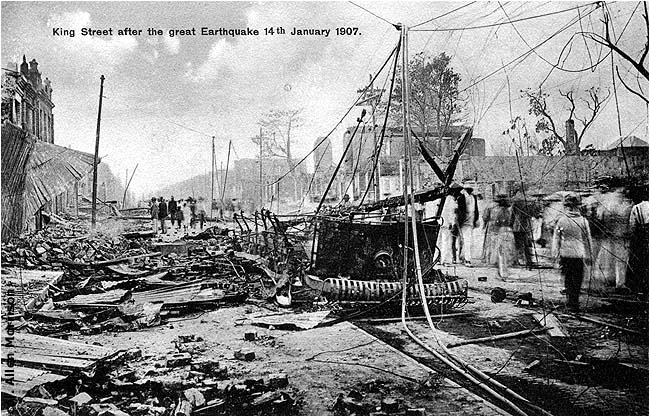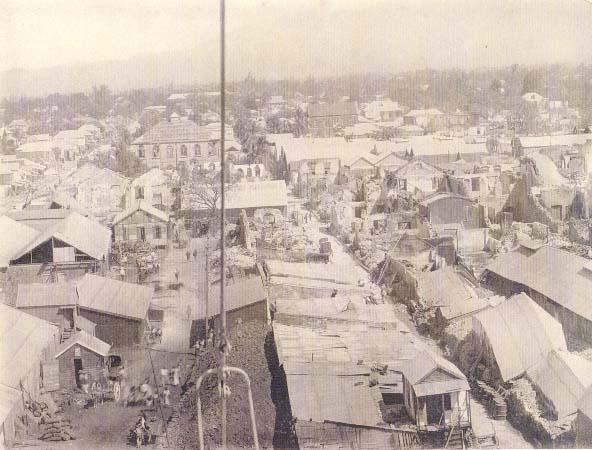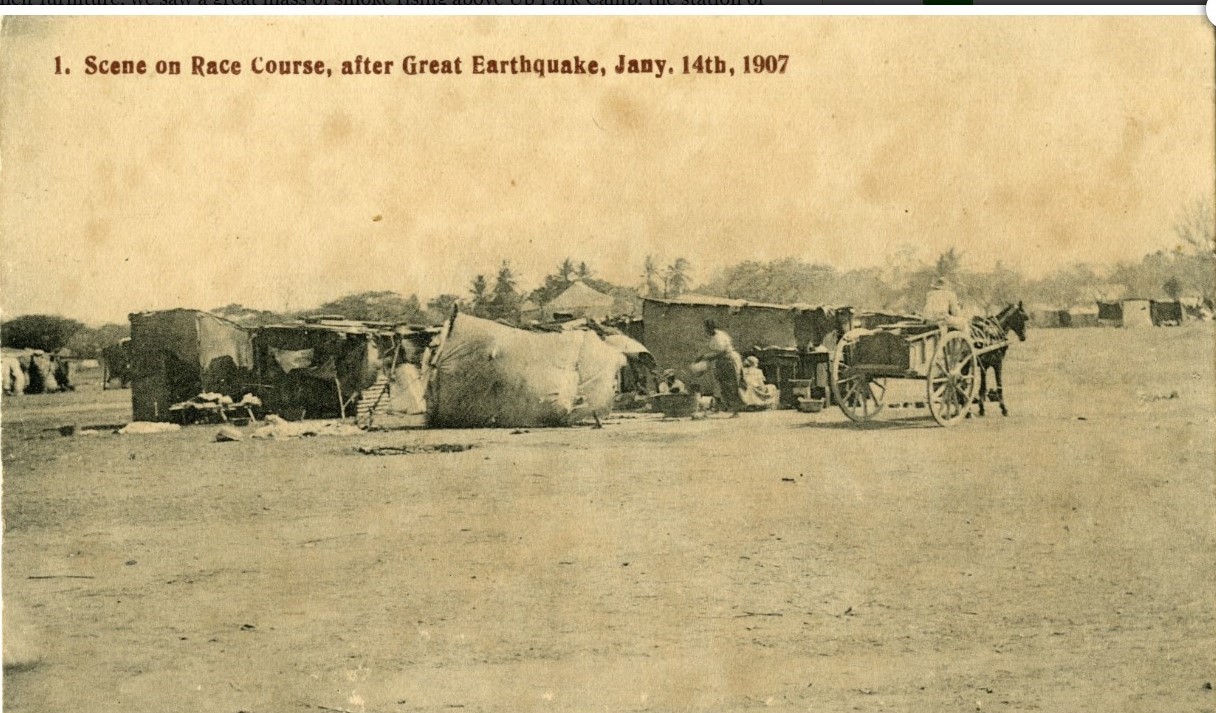
Each January, seismologists never fail to remind us that Jamaica is overdue for another massive earthquake, perhaps bigger than those of 1692, which destroyed Port Royal, and at approximately 3:30 p.m. on January 14, 1907, which devastated Kingston. Essentially, we are told that Jamaica is living on borrowed time with respect to another earthquake hitting the island.
While there were personal testimonies coming out of the 1692 event, there is a rich storehouse of individual accounts in the wake of the 1907 devastation. In a previous blog post, I wrote that “the 1907 fire and quake left an indelible mark on Jamaica’s capital for years, accounting for the death of about 800 persons.”
I further noted:
J.F. Wilson, writing in 1910, reported that “ten minutes after the first [earthquake] shock, flames burst out in the ruins and raged for three hours before any efforts were made to check them.”
He said “among the distressing features of the entire disaster was the burning of the Military hospital in which 40 soldiers were burned to death before any effort could be made to save them.”
It appeared aftershocks and fire happened simultaneously:
A second, third, fourth and fifth shock followed in close succession. By this time flames had broken out in six different sections of the town and began eating their way through the ruins, and many people were roasted alive. Their cries could be heard above the roar of the flames. Pandemonium reigned supreme.
Another account shortly after the earthquake gave slightly different details:
On the afternoon of January 14 Kingston, the capital of Jamaica, a city of about 80,000 inhabitants, was practically destroyed by earthquake and fire. The deaths number over 1,000. There were about 10,000 houses in the city and parish of Kingston, of which about 96 percent were wholly or partly of brick. Not one hundred of these buildings was in a habitable condition after the calamity.

In Through Jamaica with a Kodak, Alfred Leader, writing several months after the earthquake, declared, “recent troubles arising from the hurricane of 1903 and the earthquake of 1907 have undoubtedly caused distress, difficulty, and anxiety, and have hindered the progress and prosperity that had begun to develop.”
Myron Fuller of the United States Geological Survey toured the island, starting in March 1907. He reported on eyewitness accounts he received:
The earthquake was accompanied by a loud noise, described as a deep crushing sound, somewhat suggesting distant thunder but with less boom and more of a roar. Intermixed with the natural sounds proceeding from the earth was the crashing of the buildings and the cries of the people, the two together being described as almost deafening.
According to Fuller, darkness caused by dust followed the quake:
One of the phenomena described by all eye-witnesses was the notable darkness following the shock. The local mortar, rather poor at the best, which was used in most of the buildings, pulverized quickly, and was projected into the air together with other dust in immense quantities as the buildings fell, saturating the atmosphere until it was almost impenetrable to the sun’s rays. After the cessation of the shock it slowly settled, covering everything with a thick white mantle of fine calcareous silt.
Fuller noted something peculiar:
One of the striking features of the earthquake was the few windows which were broken. In many instances the window frames, without a single pane broken, were seen where the brick walls surrounding them had crumbled and fallen. This immunity seems to indicate that while there was much shaking there was relatively little tortional or crushing movements in the walls.

Horace Russell, in Much to Live On, recounts the experiences of Terrence Haddon Duncanson, who was to become a longstanding Baptist missionary to Panama several years later:
He had just returned to the workshop from the Savings Bank where he had deposited a shilling when the earthquake struck. At the first shock he took to his heels and was able to make it outside the building before the aftershocks. Others were not as fortunate and he later discovered that several of his workmates died when the workshop collapsed on them. Panic stricken, he kept on running, trying to make it to the Kinkeade‘s Drug Store where his brother worked. As he ran it seemed to him that the whole city was in ruins around him and he could hear the groans and cries of people trapped, injured and dying in the collapsed buildings and rubble. For a while he lost his bearings because the usual landmarks were gone but he knew he had to run towards the east and he knew where the east was. He eventually found his brother and together they made their way to the Kingston Race Course on the edge of the city.
The Kingston Race Course is now New Kingston. Those who know the city are aware that this was a fairly long trek, going north toward Cross Roads before reaching the racetrack.
Russell, who is perhaps the leading church historian from the English-speaking Caribbean, wrote:
Those who could instinctively made their way to the Racecourse since it was the largest available open space. The earthquake was followed by a fire and what the earthquake did not destroy the fire did. Added to which there was also great fear of a tidal wave as the sea had retreated well beyond the Palisadoes during the shocks and was expected to rush back at any moment. It was awful.
The events of that fateful day left an awesome imprint on Terrence’s mind. In recalling the happenings of the time he would often say that there were two things he would never forget. The first was how he did not remember that there was choir practice that evening at church and the second was a line he had repeated involuntarily as he ran to save himself. He had learned it in elementary school and it had remained a constant reminder of the power of Nature and the helplessness of Humankind before its terrors.
One touch of Nature makes all the world kin.
…. For the next two weeks his brother and he with hundreds more lived in tents at the Kingston Race Course. They were destitute and had to depend on handouts of food from the government, the churches and the goodwill of the more fortunate.
A version of the actual earthquake was given by Fuller, whom we mentioned earlier, in his report published on October 1, 1907. It was based on observations he made and “upon interviews with government officials and others who were present in the city at the time of the disaster.”
“The principal shock, which was the only one producing any, serious damage, took place at 33 minutes and 6 seconds past 3 o’clock in the afternoon of January 14, 1907, and lasted about 30 seconds,” Fuller wrote. “The vibrations were not of uniform strength, but were marked, according to descriptions, by at least three recurrent pulsations of alternating low and high intensities.” The weather, he said, was clear.
Another explanation, also written in 1907, gave reasons for the devastation of Kingston:
Mr. Charles Davison, formerly Secretary of the British Association’s Earth Tremors Committee, calls attention in the London Times (weekly edition, January 25, 1907) to the fact that the foundation of Kingston consists of beds of sand and gravel, brought down from the northern mountains. It is on ground of this kind that earthquake shocks attain their maximum intensity.
It further states:
He urges that, if Kingston is rebuilt on its present site, it may again be visited by great earthquakes, and that their effects will be all the more serious on account of the low-lying position of the town and the loose and friable nature of its foundation. There is no other harbour in the island to compare with the extensive haven between Kingston and Port Royal, and the new town will certainly not be far distant from its shores.
Was this making a case for Kingston not to be rebuilt on its current site? I’m curious as to what seismologists say.
A quasi-scientific reason was offered by Fuller with obvious reservation as to its veracity. “The shock occurred near the date of the new moon at which period, it is claimed by some, the Jamaica earthquakes are particularly likely to occur, owing to the supplementary attraction due to the conjunction of sun and moon.”
Kingston was, however, rebuilt. H.G De Lisser in his 1913 book, Twentieth Century Jamaica, made the interesting observation that “Kingston has had the advantage (my emphasis) of being destroyed by fire two or three times, and of being shaken down by an earthquake in January, 1907. Except for that little matter of the corrugated iron roofing, it has benefited much by these catastrophies (sic), having improved itself on each occasion as far as the means, tastes, and ambitions of its inhabitants would allow it to do so.”
For instance, De Lisser said in reference to King Street in downtown Kingston:
Since that year (1907) the city has got at least one street of which it has good reason to be proud, a street which as a business and commercial centre is the finest in all the West Indies. It is well paved, well served by electric cars, taxi-motors, and horsecabs; the buildings on either side are strong, earthquake proof, and sufficiently commodious for the purposes they are intended to serve; in this thoroughfare, too, are the new public gardens, and the colonnades in front of the stores enable the pedestrian to walk nearly the whole length of lower King Street without being roasted by the sun.
Kingston did bounce back, but while Jamaica waits for the next big quake, one hopes lessons learned from 1907 are being applied.
Eron Henry is author of Reverend Mother, a novel
Prescient?
http://www.jamaicaobserver.com/news/5-2-magnitude-earthquake-felt-in-Portland-and-Portmore